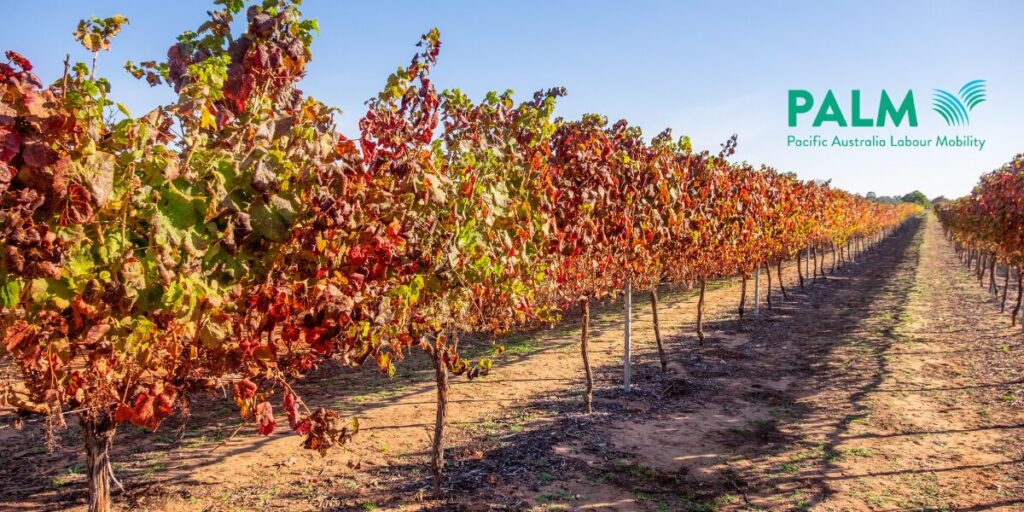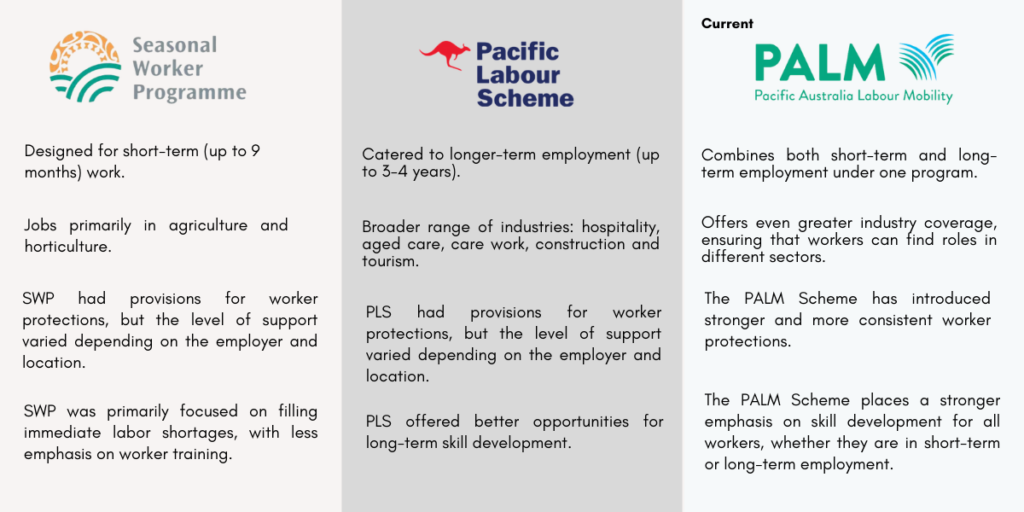Understanding the PALM Scheme Visa
The Pacific Australia Labour Mobility (PALM) scheme offers Pacific Island workers a chance to earn money in Australia, filling critical labour gaps in the agriculture, hospitality, and construction industries. The program is a lifeline for both Australia and Pacific nations. Workers from places like Fiji, Samoa, and Tonga can send money back home, boosting local economies.
The PALM scheme visa is more than just an entry permit for the Pacific Island workers. It’s an opportunity to improve their skills, earn a steady income, and support their families. At the same time, Australian businesses benefit from a reliable, motivated workforce. Since the program began, thousands of workers have participated, helping to strengthen the connection between Australia and the Pacific.
In this blog, we’ll go over the key points of the PALM scheme and what you need to know about the program. However, for the most accurate and up-to-date information on the application process, we recommend visiting official government websites to ensure you meet the latest requirements and guidelines.

PALM scheme vs Seasonal worker programme and Pacific labour scheme
From July 2023, Australia consolidated the Seasonal Worker Programme (SWP) and the Pacific Labour Scheme (PLS) into a single program called the Pacific Australia Labour Mobility (PALM) scheme. This change simplifies and streamlines the process for Pacific Island workers and Australian employers.
Previously, the SWP focused on short-term roles, mostly in agriculture, where workers could stay for up to nine months. On the other hand, the PLS catered to long-term roles (up to four years) in various industries like hospitality, construction, and aged care. The consolidation under the PALM scheme now allows for short-term and long-term work opportunities within one program, giving workers more flexibility. Workers can switch between short-term and long-term roles depending on demand and preferences.
Another significant change is the simplified visa process. Previously, workers had to apply through two separate visa streams, but now, under the PALM scheme, only one visa application process applies to all workers, regardless of the job duration. Additionally, the PALM scheme broadens the range of industries beyond agriculture to include more sectors like construction and care services, offering more diverse employment options.
The consolidation also enhanced worker protections, ensuring that all PALM scheme workers receive fair wages, safe working conditions, and access to support services, regardless of industry or length of their stay in Australia.

Who is eligible for the PALM scheme visa?
The PALM scheme is open to workers from several Pacific Island nations and Timor-Leste. To qualify for the PALM scheme visa, applicants must meet specific criteria, ensuring they are suited for work in Australia. Here’s what you need to know:
Age requirement: Applicants must be at least 21 years old to participate in long-term employment, while some short-term roles may have a lower age threshold.
Participating countries: Workers must be from nations like Fiji, Kiribati, Nauru, Papua New Guinea, Samoa, Salomon Islands, Timor-Leste, Tonga, Tuvalu and Vanuatu. Check here.
Health and character checks: Applicants must pass a medical examination and provide police clearances to meet health and character standards.
Job offer: Workers need a valid job offer from an approved Australian employer before applying for the visa. The employer must be registered under the PALM scheme to sponsor the worker’s visa.
These requirements ensure that the PALM scheme serves Australian industries’ needs and provides valuable employment opportunities to Pacific Islanders. Remember, eligibility can change, so reviewing the latest guidelines on official government websitesis crucial.
How to apply for the PALM scheme visa
Applying for the PALM scheme visa involves several steps, but the process is designed to be straightforward for Pacific Island workers. Here’s a breakdown of the key stages:
1.Check Eligibility
Before applying, meet the eligibility criteria, including age, nationality, and health/character requirements. You must be from a participating country like Fiji, Samoa, or Papua New Guinea and pass health checks.
2.Obtain a job offer
Workers need a valid job offer from an approved Australian employer. Employers must be registered under the PALM scheme and offer work that fits either short-term or long-term employment. Job opportunities are typically in agriculture, hospitality, or construction.
3.Submit visa application
Once you have a job offer, your employer will assist you with submitting the visa application. This process involves providing personal documentation, medical certificates, and police clearances. Under the consolidated PALM scheme, only one visa application is required, making the process simpler than in previous years.
4.Attend health and character checks
Workers must undergo medical checks and obtain police clearances to confirm they meet health and character requirements. These steps are vital for ensuring the safety and well-being of everyone involved.
5.Wait for Visa Approval
Visa processing times can vary, but typically, workers will receive feedback within a few weeks. It’s essential to have all documents ready to avoid delays.
By following these steps, Pacific Island workers can smoothly navigate how it is the visa application process and start working in Australia. For more detailed guidance, it’s advisable to consult official resources.
Costs and fees associated with the PALM scheme Visa
Knowing the costs involved in applying for the visa and relocating to Australia is essential. Here’s a breakdown of the potential expenses:
Visa application fees: The cost of the visa application is typically covered by the employer. Under the PALM scheme, employers are responsible for paying upfront visa costs and can later recover a portion of these expenses through wage deductions in compliance with Australian employment laws.
Medical examination fees: Workers must pay for required medical exams and obtain police clearances. These health and character checks are essential for securing the visa and typically vary in cost depending on the country.
Travel costs: Employers are responsible for arranging and paying workers’ flights to and from Australia. However, in some cases, the worker may be responsible for repaying some of these costs through agreed-upon wage deductions.
Accommodation and living expenses: While some employers may provide accommodation or assist in finding housing, workers should be prepared to cover their day-to-day living expenses, such as food and utilities.
A budget for these costs before beginning the application process is essential to keep in mind.
What happens after you arrive in Australia?
Once Pacific Island workers arrive in Australia through the PALM scheme, there are several key things they need to know to ensure a smooth transition and successful work experience. Click here to see the resources in your language:
Orientation and support services
Upon arrival, workers typically receive an orientation to help them adjust to their new environment. This includes familiarising them with workplace expectations, Australian laws, and their rights as workers. Employers registered under the PALM scheme must provide ongoing support to ensure workers feel comfortable and well-prepared for their jobs.
Adjusting to life in Australia
Cultural differences, language barriers, and homesickness are common challenges workers face. However, support services and community groups often help workers adapt to life in Australia, providing a sense of belonging and connection.
Worker rights and protections
Under the PALM scheme, workers are entitled to fair wages, safe working conditions, and proper housing. The program ensures that all workers are protected under Australian labour laws, including those related to minimum wage and working hours. Workers also have access to dispute resolution services if any issues arise.
Sending Money Home?
One of the key motivations for participating in the PALM scheme is the ability to send money back home. Workers can use reliable remittance services, like Rocket Remit, to transfer funds to mobile wallets available in countries such as Fiji, Vanuatu, Papua New Guinea, Samoa, and Tonga.
Rocket Remit provides a secure and efficient way to support families and communities in the Pacific Islands.
Available Mobile Wallets with Rocket Remit:
Fiji: Vodafone M-PAiSA and Digicel MyCash
Vanuatu: Vodafone M-Vatu and Digicel MyCash
Papua New Guinea: Banks available there are ANZ, Westpac, BSP, and Kina Bank.
Samoa: Vodafone M-Tala and Digicel MyCash
Tonga: Digicel MyCash
Using mobile wallets and Rocket Remit for your money transfers, you can ensure that your funds reach your loved ones swiftly and securely. This reliable service offers a fast, safe way to support your family back home.
About Rocket Remit
Rocket Remit is the world’s fastest international money transfer service. Send money instantly to over 60 overseas countries at very competitive rates.
Use the country selector to choose the country and check the rate.
Click here for more information on how to send money using Rocket Remit.
Download the Rocket Remit app from Google Play or the Apple Store